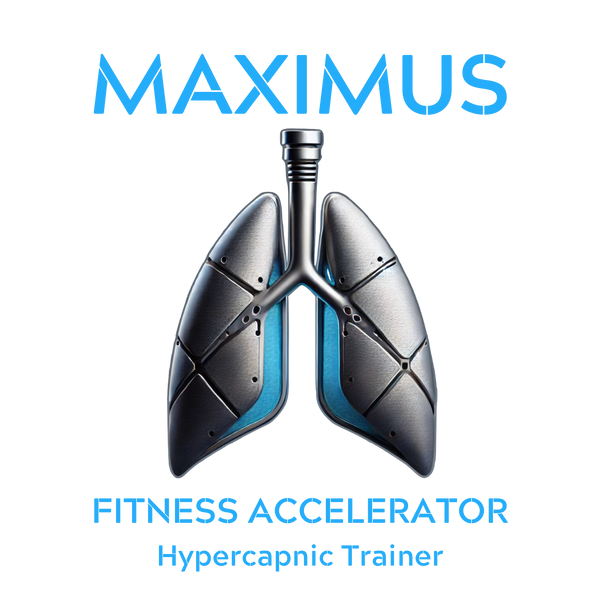
How Respiratory Muscle Trainers Alleviate Stress and Anxiety
Share
How Respiratory Muscle Trainers Alleviate Stress and Anxiety
In today's fast-paced world, stress and anxiety have become common companions for many people. While there are various methods to manage these conditions, one innovative tool that has shown promise is the respiratory muscle trainer (RMT). Originally designed to enhance athletic performance by strengthening the muscles involved in breathing, RMTs are now being recognized for their potential mental health benefits. Let's explore how and why these devices can help alleviate stress and anxiety, and how to use them for the best results.
The Connection Between Breathing and Stress
Breathing is a powerful tool that directly influences our nervous system. When we're stressed or anxious, our breathing tends to become shallow and rapid, which can exacerbate feelings of tension and panic. This is because shallow breathing limits oxygen intake and increases carbon dioxide levels in the blood, which can trigger the body's stress response.
Conversely, deep, controlled breathing can activate the parasympathetic nervous system, which promotes relaxation and counteracts the stress response. This is where respiratory muscle trainers come into play.
How Respiratory Muscle Trainers Work
RMTs provide resistance during breathing exercises, making it more challenging to inhale and/or exhale. This resistance training strengthens the respiratory muscles, similar to how lifting weights strengthens skeletal muscles. Over time, this leads to more efficient and controlled breathing patterns.
Why RMTs Help Alleviate Stress and Anxiety
Enhanced Respiratory Muscle Strength
Why It Matters: Stronger respiratory muscles can improve breathing efficiency, making it easier to take deep, calming breaths even during stressful situations.
How It Helps: Improved respiratory muscle strength reduces the effort required to breathe deeply, facilitating better oxygen exchange and promoting a sense of calm.
Improved Breathing Control
Why It Matters: Having better control over your breathing allows you to consciously manage your breath in stressful moments, helping to activate the relaxation response.
How It Helps: Regular use of RMTs trains the respiratory muscles to handle increased workloads, making it easier to maintain steady, deep breathing patterns.
Reduced Perception of Breathlessness
Why It Matters: Anxiety often causes a sensation of breathlessness, which can spiral into more severe panic. Reducing this perception can break the cycle of anxiety.
How It Helps: By strengthening the respiratory muscles, RMTs can help alleviate the feeling of breathlessness, reducing the anxiety that comes from struggling to breathe.
Lower Stress Hormone Levels
Why It Matters: High levels of stress hormones like cortisol can negatively impact overall health. Deep, controlled breathing helps lower these hormone levels.
How It Helps: Using RMTs to facilitate deep breathing can help lower cortisol levels, reducing the physiological effects of stress.
Using Respiratory Muscle Trainers for Best Results
Start with Proper Training
Why: Just like any other muscle training, it's important to start with proper technique to maximize benefits and prevent injury.
How: Begin with lower resistance settings and gradually increase as your muscles adapt. Follow instructions provided with your RMT device or seek guidance from a respiratory therapist or healthcare professional.
Consistency is Key
\Why: Regular use is essential to see significant improvements in respiratory muscle strength and stress reduction.
How: Aim to use your RMT for about 5-10 minutes, twice a day. Consistency will yield the best results over time.
Combine with Breathing Exercises
Why: Combining RMT use with specific breathing exercises can enhance the benefits.
How: Practices such as diaphragmatic breathing, box breathing, and paced respiration can be performed using the RMT to train the muscles and promote relaxation.
Monitor Your Progress
Why: Tracking progress helps you stay motivated and see the benefits of your efforts.
How: Keep a journal of your sessions, noting resistance levels, duration, and any changes in stress or anxiety levels. Many RMT devices come with companion apps to help monitor your progress.
Create a Calm Environment
Why: A calm environment enhances the effectiveness of your breathing exercises and reduces external stressors.
How: Find a quiet, comfortable space for your RMT sessions. Consider using calming music or aromatherapy to create a more relaxing atmosphere.
Real-Life Impact
Numerous users have reported significant reductions in stress and anxiety levels after incorporating RMTs into their routines. For instance, a study published in the Journal of Psychosomatic Research found that participants who used inspiratory muscle trainers experienced notable reductions in anxiety symptoms and improved overall well-being. Another research article in Chest journal highlighted that patients with anxiety disorders who used RMTs showed improved respiratory function and decreased anxiety scores.
Conclusion
Respiratory muscle trainers offer a unique and effective way to combat stress and anxiety. By strengthening the muscles involved in breathing and promoting better breathing control, RMTs help activate the body's natural relaxation response. Consistent use, combined with proper training and breathing exercises, can significantly enhance your ability to manage stress and anxiety.
Incorporating an RMT into your daily routine is a simple yet powerful step towards better mental health. Breathe deeply, stay consistent, and unlock the calming benefits of stronger, more efficient respiratory muscles.
